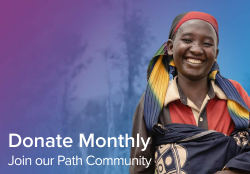Posts Tagged ‘Chicagoland’
Partner Spotlight: Greg & Olivia Evans on “Who is my neighbor?”
When their children were school-age and began attending the neighborhood school right around the corner, Greg and Olivia Evans quickly realized something. The students their children were sitting next to in class did not look like them. From a distance, they watched school counselors and teachers meeting the needs of recently resettled refugees. They saw these students learning a new language and navigating a huge life change.
Connecting with World Relief Chicagoland
As they saw this, Olivia (and Greg) began wondering: “How can we be a part of this? Is there a way for us to give kids equal footing in the same way we want to provide for our own kids? Is there a way for us to help make a difference? And that’s where we met World Relief.”
From this point forward, the Evans’ partnership with World Relief has only expanded. They’ve brought multiple neighbors onto the journey with them. They had friends saying – “I can drive a car.” or “I can be of service.” In fact, their neighbor around the corner is still involved. He will say, “I’m doing an airport run tonight.”
For the Evans, it all comes back to the concept of loving your neighbor. Loving your neighbor can be grand or simple, and there is room for all of that in World Relief’s work. It’s just a matter of asking yourself, what will I do?
Answering “Who is my neighbor?”
One of the ways Greg and Olivia are responding is through financial partnership. Each year, they take time to talk with their kids. They talk about where they can have a tangible financial impact and what feels important to them. For the last several years, World Relief has been at the forefront of what is important.
Ultimately, for Greg (and Olivia) it comes back to the question: “Who is my neighbor? Everyone is my neighbor. How do I show love? In any way I can.”
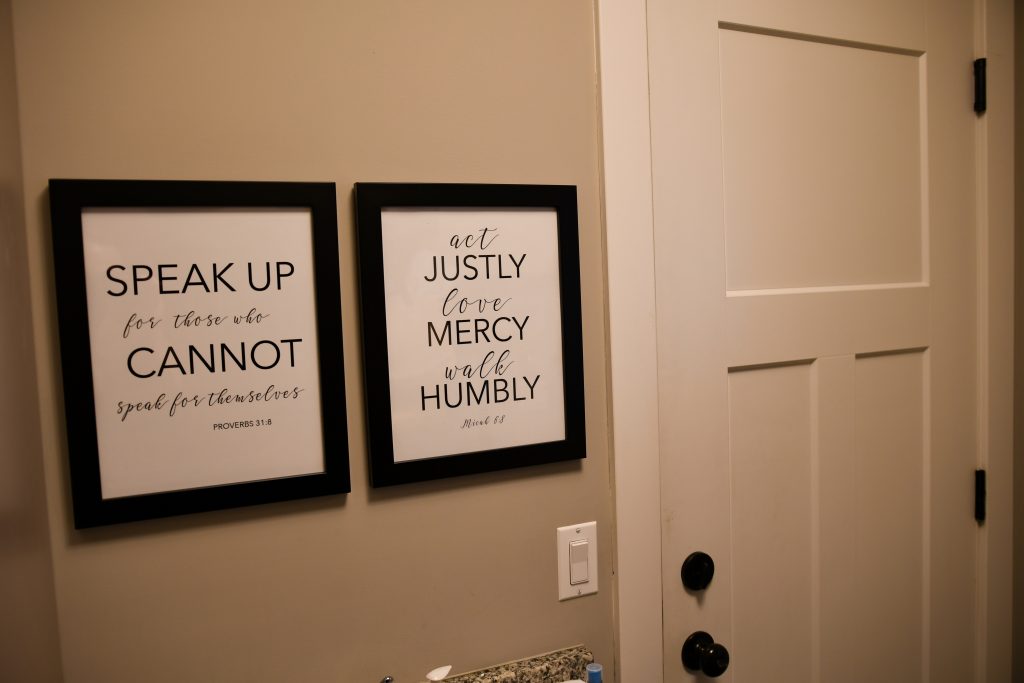
Welcoming New Neighbors
World Relief Chicagoland relies on the generosity of partners, like Greg and Olivia, to welcome and walk alongside immigrants and refugees as they rebuild their lives. For over 40 years because of the generosity of others, World Relief has welcomed thousands of new neighbors helping them reach stability and responding in love.
Will you give to build welcoming and just communities for immigrants and refugees to thrive?
Photo Essay: The Afghan Seamstress Sewing Beautiful Garments in Her New Community
Meet Samira
On a cold day in the middle of Illinois winter, the home of Samira* and her family has vibrant colors. Though the family only arrived in the U.S. a few months before, they have been busy. And much of what Samira has done is create. This photo essay showcases the beautiful garments that Samira makes.
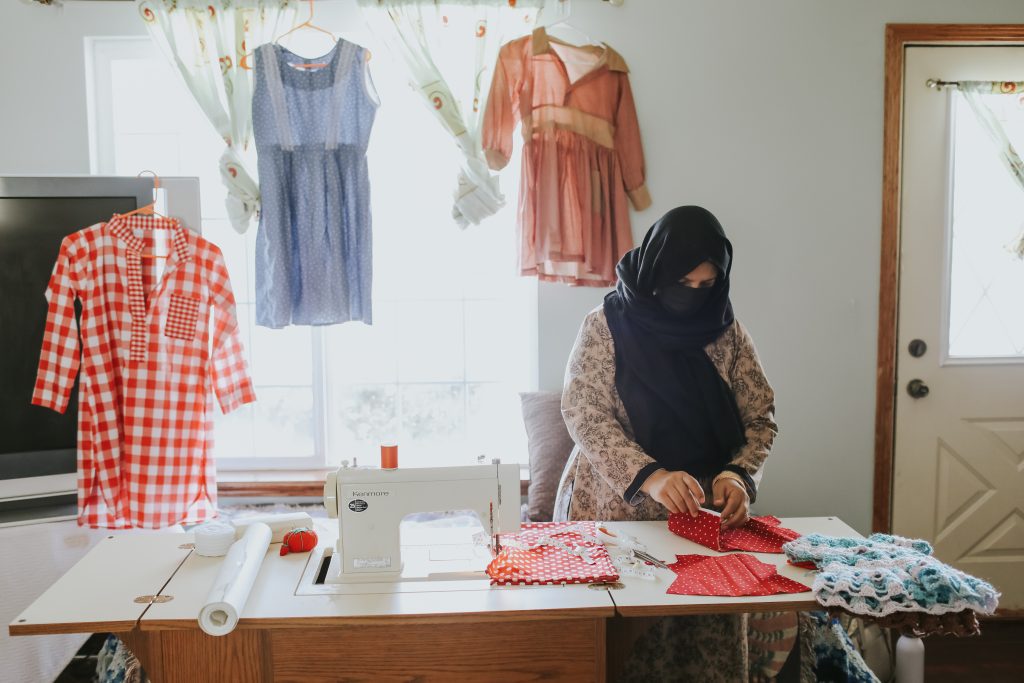
In Afghanistan
In her home community in Afghanistan, Samira* was a gifted seamstress. With her skills in sewing and crocheting, she crafted gorgeous wedding gowns, dresses, and other apparel.
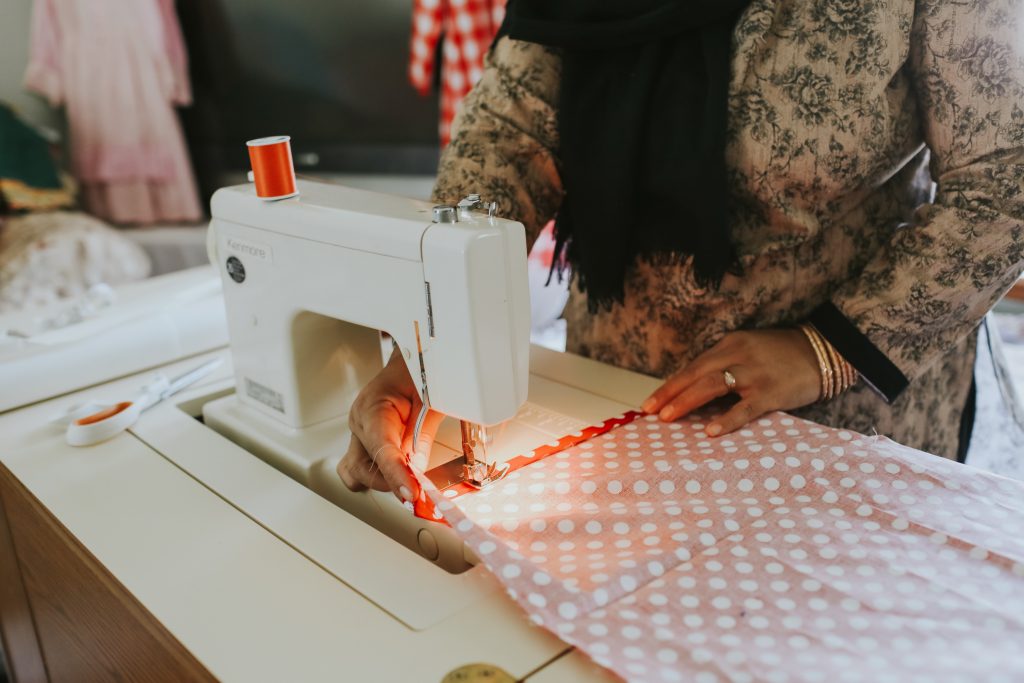
The days of making wedding dresses for friends and relatives in her hometown in Afghanistan are long gone. Today, they are documented only through a few photo prints.
On the Journey
Samira carried those photos with her when the family Afghanistan. They came with her to the U.S. military base where her family awaited resettlement. And now, in their new home in the suburbs of Chicago, Samira looks at her photos as mementos of a life left behind.
But even on their family’s journey, Samira found ways to use her talent and scarce resources to meet her family’s needs. She transformed a bedsheet into a dress for her daughter. She made yarn by hand from spare materials.
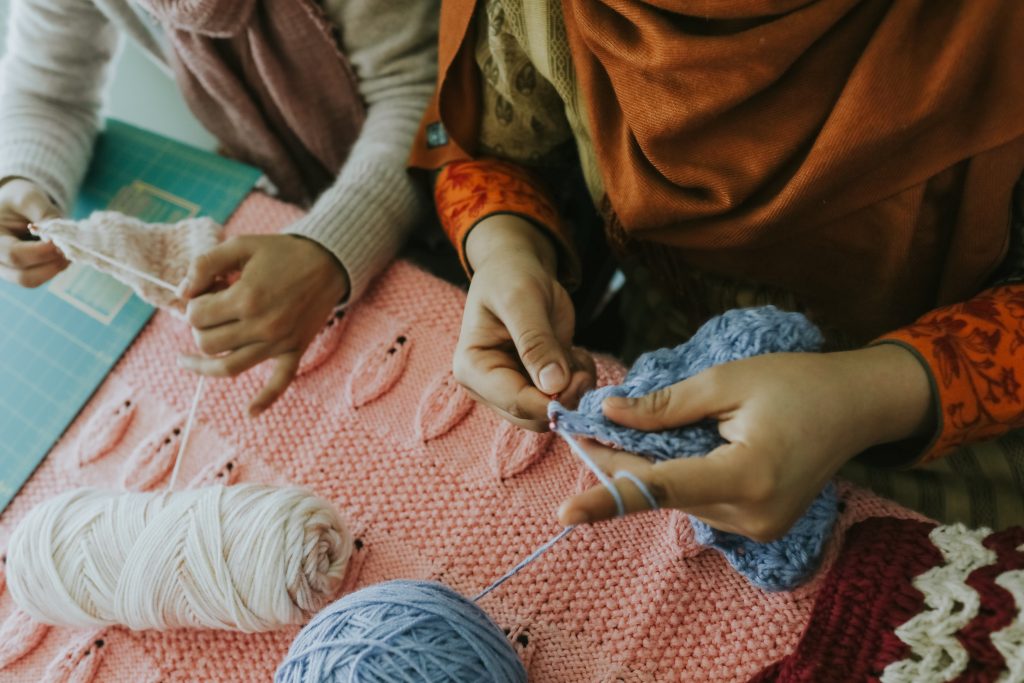
In a New Community
When World Relief Chicagoland welcomed Samira and her family to Illinois, staff learned of Samira’s skill as a seamstress. Thanks to the generosity of our supporters, she gained a sewing machine, fabric, thread, and other sewing tools. Now, she uses her skills to create a home and support her family in the United States.
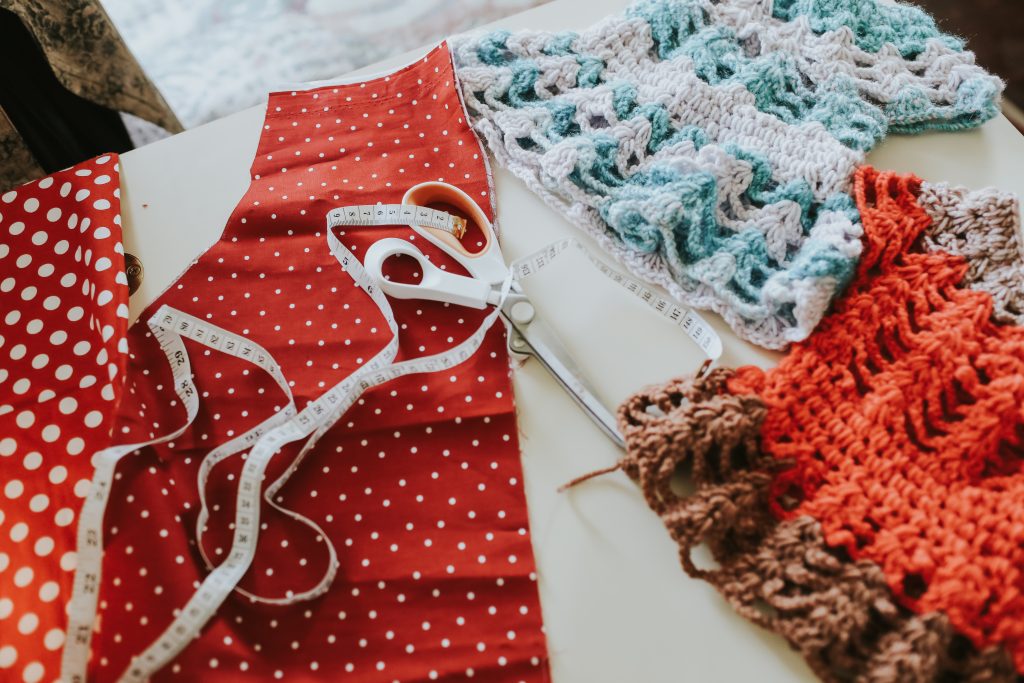
The next time World Relief Chicagoland staff saw her, Samira and her daughters were wearing brand-new dresses sewn just that week!
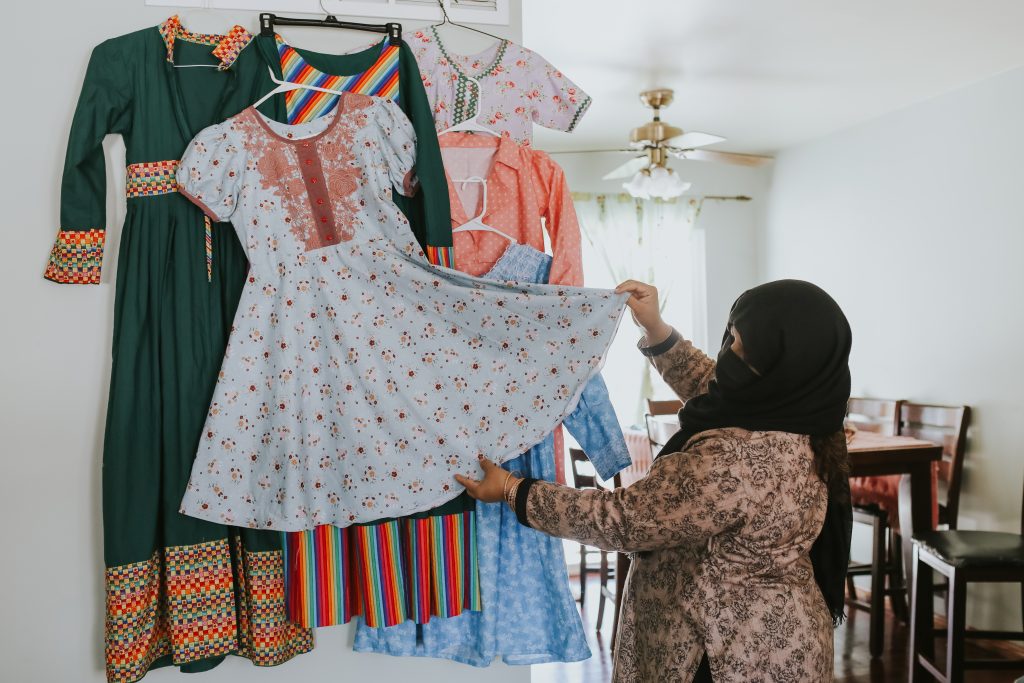
In her home, during cold Chicago winter, Samira crochets scarves, gloves, and hats. She and her daughters sew dresses. And while Samira left so much behind, now she creates beauty in her new community.
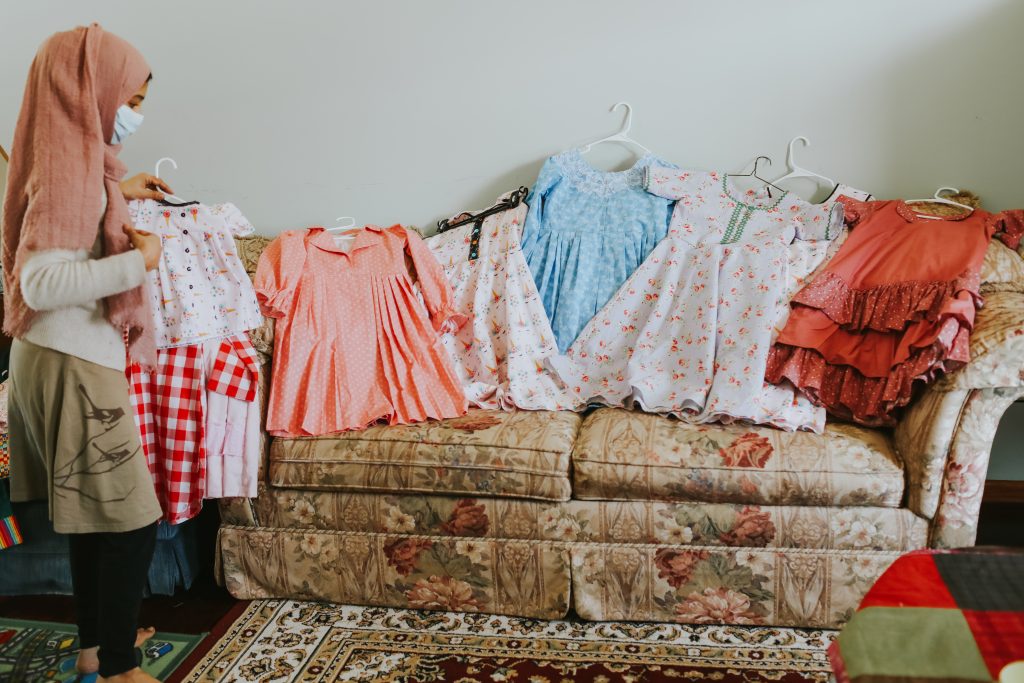
Images in this photo essay by Roxanne Engstrom of Hawa Images.
Read More
World Relief Chicagoland’s 2021 Year in Review is an annual report that features Samira’s story along with other stories of hope.
Click here to read the Year in Review.
As you read, we hope that reflecting on the year behind us inspires you. And that it reminds you of the power of creating welcoming community together.
Video: We Believe the Church Can Change the World
Why the Church Has Hope for a Hurting World
At World Relief, we believe that when the Church is mobilized to achieve its full potential, it has the power to change our world.
This is because we believe that the local church is God’s plan to reveal his mercy, compassion and truth to people around the world. In each of our communities, local churches function as a social network. Churches have influence. Churches have the opportunity to share truths about God’s love, compassion, and justice.
And with the power of the Holy Spirit, we believe that the Church can accomplish more than humans could ever possibly do alone.
What is the task of the church? We are to embody Jesus Christ by doing what He did and what He continues to do through us: declare—using both words and deeds—that Jesus is the King of kings and Lord of lords who is bringing in a kingdom of righteousness, justice, and peace.
Steve Corbett, When Helping Hurts: How to Alleviate Poverty without Hurting the Poor and Yourself
How World Relief Equips the Church
World Relief Chicagoland has partnered with churches for more than 40 years. And the global World Relief network has partnered with churches across the U.S. and around the world for over 75 years. Together, thousands of church partners are creating long-term change in vulnerable communities. Today, we’re a movement of over 5,000 churches, across 20 countries, sharing hope and love to families in vulnerable situations.
World Relief believes the Church can change the world. Do you?
Watch the video below to hear more about our vision for churches.
Watch more videos of hope on World Relief Chicagoland’s YouTube channel or learn about how your church can partner with us to create lasting change.
More like this:
New Opportunity in the U.S.: Jenny’s Story
I Was No Longer Safe in My Country: Yomardy’s Story of Seeking Asylum
8 Things You Need To Know About the Ukrainian Refugee Crisis
Over the last week, our hearts have been broken as we watch images of mothers and children fleeing Ukraine while their husbands, sons, fathers and brothers stay behind to fight. Indiscriminate violence is placing innocent lives in danger, with reports already indicating a tragic loss of life. Hundreds of thousands of Ukrainians are beginning to come to terms with the shocking reality of life as a refugee. As the situation continues to unfold, we will keep you updated and informed. Read on to learn more about what’s happening in Ukraine, the growing refugee crisis, and what you can do to help.
1. What’s going on in Ukraine and why are people fleeing?
Russian-Ukrainian tension has existed since the fall of the Soviet Union in 1991. Then, the largest country in the world suddenly collapsed into 15 smaller European nations, including Ukraine. At the time, Vladimir Putin, now president of Russia, called the collapse the “greatest geopolitical catastrophe of the 20th century.” Since the fall, Putin has desired to reclaim the lost territory, which he sees as “a single whole.”
Today, threatened by the expansion of Western influence and Ukraine’s desire to join NATO — The North Atlantic Treaty Organization — Russia feels a greater need and urgency than ever to exert and protect its influence in the region.
February saw a huge troop buildup along Ukrainian borders. On Thursday, February 24th, 2022, Russia launched a full-scale invasion of the country.
Civilian targets are not being spared. Indiscriminate bombing has damaged residential buildings, hospitals, schools, and crucial infrastructure that supplies heat, water, and electricity to citizens.
As of March 3rd, over one million refugees had fled across neighboring borders. This number is estimated to grow to over seven million during the coming weeks and months.
2. Where are people going? What’s happening at the borders?
Most Ukrainians are fleeing for their closest border with neighboring European countries. The sudden wave of people gathering at border crossings has created large humanitarian needs. These locations are in urgent need of basic necessities including water, food, heat and shelter as the wait at the border for processing can take three to four days. As of March 3rd, Poland has been the primary recipient of refugees, with over 548,000 refugees crossing. Other countries that are seeing large numbers* of refugees are:
- Hungary 139,686
- Moldova 97,827
- Slovakia 72,200
- Romania 51,261
- Russia 47,800
- Belarus 357
*These numbers reflect reports as of March 3rd, 2022.
3. Who is fleeing?
Tragically, it is mostly women and children who are crossing the borders alone. Men between the ages of 18-60 have been asked by Ukrainian President Zelensky to stay behind to join the defense forces. This means women and children are leaving home without their husbands, fathers and brothers. This is also resulting in grave concerns about security and protection as many young women and children without adult guardians are crossing unaccompanied without money or visas. Unfortunately, this makes them extremely susceptible to sexual violence, exploitation and trafficking. UNICEF, IOM and others are mobilizing protection units to be spread along the border crossings.
4. There has been talk of discrimination at the border. What’s going on there?
There is a large concern about third-country nationals — citizens of other countries who were in Ukraine at the time war began. Many were students studying in Ukraine from Africa. Initial reports indicated that many of these individuals were not being permitted to cross the border out of Ukraine to Poland with others, and were actually barricaded for a time in shelters without basic expected facilities. Furthermore, many others without documentation (passports, etc.) were simply refused shelter and instead temporarily detained. However, after swift international media concern, this problem seems to have been resolved and officials are now allowing everyone to enter Poland regardless of ethnicity, refugee status or documentation.
5. Are there any policies in place in the E.U. and/or U.S. that could help protect Ukrainian Refugees?
Poland is currently considering passing a Parliamentary Act giving temporary residence rights to refugees coming in from Ukraine which would permit people to work and live in the country. This would be hugely beneficial to the millions seeking to rebuild their lives following this conflict.
In terms of U.S. policies, the Biden administration granted Temporary Protected Status (TPS) to Ukrainians who are already in the U.S. This allows those whose temporary visas may be about to expire or who may have overstayed a temporary visa to stay lawfully in the U.S. Additionally, this also allows them to gain work authorization to work to support themselves, rather than being required to return to Ukraine at a time when doing so would be incredibly dangerous. We’re thankful for this action.
Beyond that, the Biden administration and Congress should continue to focus on rebuilding the U.S. refugee resettlement program and our asylum system so that Ukrainians and others who have fled their homes with credible fear of persecution can find refuge in the U.S. going forward.
6. Will Ukrainian refugees come to the U.S?
Historically, a significant number of Ukrainians have come to the United States, including many admitted through the U.S. refugee resettlement program through a specific provision known as the Lautenberg Amendment, which offers resettlement to particular religious minorities from the Former Soviet Union.
World Relief has resettled over 13,000 refugees from Ukraine over the past 18 years. In fact, in the last 10 years, World Relief resettled 7,300 Ukrainians. That is nearly 40 percent of all Ukrainian refugees resettled to the U.S. during that time.
Our hearts and prayers are with the many Ukrainians we’ve walked alongside. This includes many on staff in the United States who are originally from Ukraine. And who are now deeply concerned for loved ones still within the country.
While some fleeing Ukraine could eventually qualify for resettlement to the U.S., most are going to neighboring countries in Europe . So far, these countries have been willing to offer safety and protection.
We do anticipate that some Ukrainians who already have temporary U.S. visas may travel to the U.S. Once here, they may consider seeking asylum. World Relief’s immigration legal services teams are actively providing guidance to those in the U.S. on the legal possibilities for seeking asylum or pursuing family reunification visas.
More information for Ukrainians in the United States is here.
7. What is World Relief doing to help Ukrainians?
World Relief is currently preparing to send funds to our partners in the region. These partners are providing assistance on the ground.
We are also ready to resettle Ukrainian refugees when we have the opportunity. And we are providing assistance to those already in the U.S. who are desperately seeking help for their families. The situation is changing rapidly. But so are the ways we can respond.
Above all, we are constantly lifting those in need up in prayer — whether for peace in Ukraine or relief from disasters around the world.
8. How can I help?
PRAY: As in all things, we first turn to prayer. Pray for peace in Ukraine, for wisdom and courage for the global leaders involved, and for faith and comfort for the families suffering in the midst of this conflict right now.
ADVOCATE: You can urge the Biden administration to provide emergency humanitarian funding. This will help meet the immediate needs of displaced Ukrainians and those who remain in Ukraine. The response will include partnering with local organizations in Ukraine and neighboring countries. Additionally, you can encourage countries of refuge to continue to provide protection for displaced Ukrainians by processing and providing legal protections for refugees and other displaced persons.
GIVE: Finally, you can offer financial support at this crucial time by giving to World Relief’s Disaster Response fund, mobilizing our partners, churches and staff to respond to the critical needs of the most vulnerable needlessly suffering in Ukraine and around the world
Lent Prayer Guide: A Call to Give
What is Lent?
Lent is a time to reflect on the death and resurrection of Jesus. In this time of reflection, Lent is also a call to give up something for 40 days. We do this in order to not only become more aware of God’s presence in us, but to give in to who God is shaping us to be.
Lent feels more poignant this year. We are witnessing widespread suffering across the world and navigating many emotions in our own personal lives. Together we help hundreds of refugees and immigrants who fled their home and are now seeking safety, rebuilding their lives, and finding belonging in a new home. All this takes work and takes people – like you and me – coming together to acknowledge these realities and step forward into what God has for us.
There is a question that begs our attention. How is God calling you to give up, give in, and give out during this season of Lent?
A Season of Giving
The Lenten season is unique for Christians because it reminds us of what Jesus endured on our behalf. He suffered by being beaten and nailed to a cross, died in front of his family and loved ones, was buried in a tomb, and then was resurrected defeating sin once and for all.
The actions Christ displayed for us compels us to respond during this Lenten season. Here are four tangible ways you can enter into Lent with World Relief Chicagoland:
- Pray daily for refugees and immigrants in our community. Pray for those who are currently displaced all around the world.
- Learn from your friends, neighbors, and right here on World Relief Chicagoland’s blog about how you can welcome and walk alongside refugees and immigrants in your community.
- Give your time and resources to help refugees and immigrants rebuild their lives and flourish in their new home.
- Advocate for refugees and immigrants by contacting your elected officials.
As you can see, at World Relief Chicagoland this Lenten season is a call to reflect on giving. What is holding you back from seeing what you need to give up? How can you make space to intentionally reflect and give in to how God is moving? In what way will you give out in response to what God is doing through you?
Download the Lent Prayer Guide: A Call to Give
For these reasons we created this Lent prayer guide for you. Through this guide you will join others throughout the World Relief community in daily prayer for refugee and immigrant neighbors. May this season of Lent be filled with giving up what is holding us back, giving in to what God has for us, and giving out what God pours into us.
More Resources to Pray with World Relief Chicagoland:
A Model for Corporate Partnership: GForce Life Sciences
At World Relief Chicagoland, we love working with partners in a holistic way especially when we share the core value of serving people in vulnerable situations. A holistic partnership is about more than writing a check (though it is one way to make an impact). It involves mobilizing people in your company to engage in a meaningful way that leaves a positive impact on everyone. We would like to highlight one of our corporate partners – GForce Life Sciences.
Moving Towards Impact
Their mission statement is to make an impact one person at a time. GForce Life Sciences was introduced to World Relief by President John Webber’s wife, Tricia. Tricia served as a volunteer and former staff with World Relief. The Webber family had a front-row seat to how challenging it is for refugees and immigrants to be dropped into the U.S. and forced to acclimate to life here immediately. They came to believe that partnering with World Relief was the right next step for them.
In addition to English classes, World Relief assisted with finding jobs, a home, classes and more. There are so many things that we take for granted like registering for school or navigating medical appointments. These were the things that Tricia got to help the families with. She also taught in World Relief’s “pre-school” while parents were taking ESL classes.
-John Webber, President and CEO of GForce Life Sciences
A Mutual Impact
In addition to the financial partnership from GForce Life Sciences, their team shows up to be part of Conversation Cafés. These cafés bring volunteers and English language learners together to practice English in a casual, yet guided setting. Every time John and his team join a Conversation Café they make an impact, bond as a team, and are blessed by their new friends. There are smiles for days.
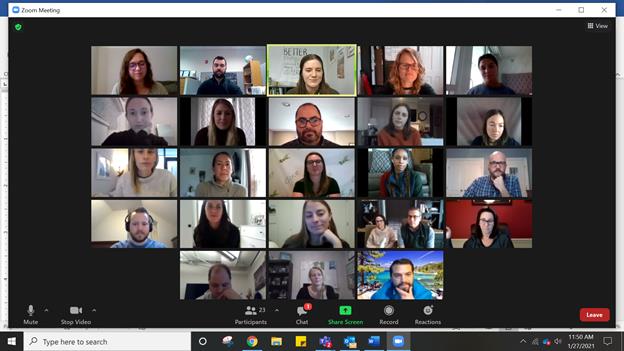
GForce wanted to support WR financially, but to really “make an impact” we also wanted to invest some of our time. It’s made an impact, not just on our new neighbors from abroad, but on our team as well. They love it!
-John Webber, President and CEO of GForce Life Sciences
Exploring Your Impact
Another way that many companies partner with World Relief is through hiring refugees and other immigrants who are eager to work. World Relief has more than 30 years of experience connecting qualified, authorized, and reliable employees with leading companies in the United States. Through working with Employment Services, your company can find great employees and make a difference. We would love to work with you and your team.
When you partner with World Relief in a holistic way, you get to have a deeper impact.
Ready to Become a Corporate Partner?
Contact Carrie Woodward to begin the conversation and learn how.
Continue Reading:
Finally, I’m Home: Raphael’s Story of 8 Years Waiting for Resettlement
I Was No Longer Safe in My Country: Yomardy’s Story of Seeking Asylum
Celebrating International Mother Language Day
Perhaps like me, you were surprised and intrigued to learn that International Mother Language Day (IMLD) is a global celebration. First proclaimed in 1999 by UNESCO, the goal of the day is “to promote linguistic and cultural diversity and multilingualism.” This year, the theme of IMLD is about the use of technology in language education.
From hot spots and mobile devices to software and virtual classrooms, World Relief has used the power of technology to serve people from over 50 different languages and 100 different countries.
Here are a couple of the benefits of technology that we have seen.
Fewer Barriers to Learning
Hosting classes on zoom has removed barriers like transportation and childcare. Now parents with young kids, immunocompromised individuals, and families that are still in need of a car can learn English. Breakout rooms give students opportunities to connect with one another. Sometimes students join from their apartment, a public park, or in their car. It is so special to see them finding joy and comfort in their classroom communities.
Volunteering is More Accessible
From all over Illinois, the community of volunteers supporting and contributing to vibrant online classes is inspiring. People, like you, log on regularly and find a place to make a difference. In addition to virtual classes, there are virtual tutoring opportunities to help students become better at navigating everyday life in the United States.
Learning English is a vital step to help someone navigate life in the United States. The ability to speak English empowers immigrants to read signs at grocery stores, contribute to parent-teacher conferences, comprehend medical appointments, and so much more. While learning English is necessary here in the United States, I believe that different languages are a beautiful gift from God that should be celebrated. A quote that Teacher Ashley Heredia shared with me captures some of this sentiment.
“Language is the road map of a culture. It tells you where its people come from and where they are going.”
-Rita Mae Brown
Many of the people in our English classes have powerful and beautiful stories. It is a joy to find yourself in a community with people who are different from you. When you experience being welcomed by someone in their mother language, it is an honoring and beautiful moment, one I hope to never take for granted.
Celebrating Languages
Check out this quick video of one of our classes sharing how to say “welcome” in their mother languages. And then consider how you could get involved in virtual English education.
Other Volunteer Stories:
My Life Motto: Becoming a Wounded Healer
The Volunteer and Refugee Friendship Helping Both Friends Succeed
Finally, I’m Home: Raphael’s Story of 8 Years Waiting for Resettlement
“Anything can happen and your future is over…after years of war, it was hopeless.”
Meet Raphael
Growing up in the Democratic Republic of Congo, Raphael was the youngest brother of five older sisters. Together with his family of sisters and a single mother, Raphael was constantly uncertain about the future. Conflict in their homeland, instability, and poverty are the things that he says he doesn’t want to remember.
Waiting for Resettlement
Eventually, Raphael fled to seek a better life. He found himself in a refugee settlement in Namibia, where he applied for asylum again and again in different countries. Just waiting to find a place to call home. Waiting for resettlement.
“The thought of saying one day I wish I could be an American…I could not even dream of it because it was impossible. It couldn’t come to be, so why dream of it? And then, all of a sudden, there is this new door that is just opened for you.”
Raphael, a refugee who was granted entry to the U.S. in 2018
After eight years of waiting, Raphael was granted entry into the United States in May 2018. With World Relief, he set out to begin a new life.
Watch the video below to hear Raphael share about his experience of being a refugee and gaining the opportunity to come to the United States… building relationships with staff and volunteers along the way.
Resettling Refugees for More than 40 Years
For more than 40 years, World Relief has partnered with volunteers from the community to welcome and serve immigrants and refugees across the Chicago area. Together, we have helped thousands of refugees like Raphael achieve stability and work toward a future they may not have dreamed was possible.
You can help welcome refugees like Raphael by applying to volunteer with World Relief Chicagoland today. Take the next step toward building relationships and being part of “welcome” for another refugee like Raphael.
Watch other stories of transformation on World Relief Chicagoland’s YouTube channel!
More like this:
New Opportunity in the U.S.: Jenny’s Story
I Was No Longer Safe in My Country: Yomardy’s Story of Seeking Asylum
Cozy Recipes for Winter from 5 Different Cultures
It’s February, and for those of us in Chicago, that means frigid winter temperatures. Winter means brisk walks breathing in the cold winter air and snow days spent bundled up indoors. These cold, dark months feel like the perfect excuse to get cozy.
And when I think of cozy, I think of hot drinks. I think of comforting foods that warm me up on a cold day. Chicago is a diverse and culturally rich city. Thankfully, that means a plethora of options when it comes to cold weather comfort food from dozens of cultural traditions. And at World Relief Chicagoland, we are all about celebrating that diversity. We serve families and individuals from dozens of countries with unique cultures and histories. In my opinion, one of the best parts of this is learning about and experiencing new foods and customs.
This roundup of recipes brings you delicious soups and stews from across the globe. Each is written by a cook from different background and is a unique expression their creativity and culture.
Why not test out one of the recipes below today?
Recipes for Cozying Up this Winter
Creamy Vegan Ramen Noodles
Recipe by Joanne Molinaro
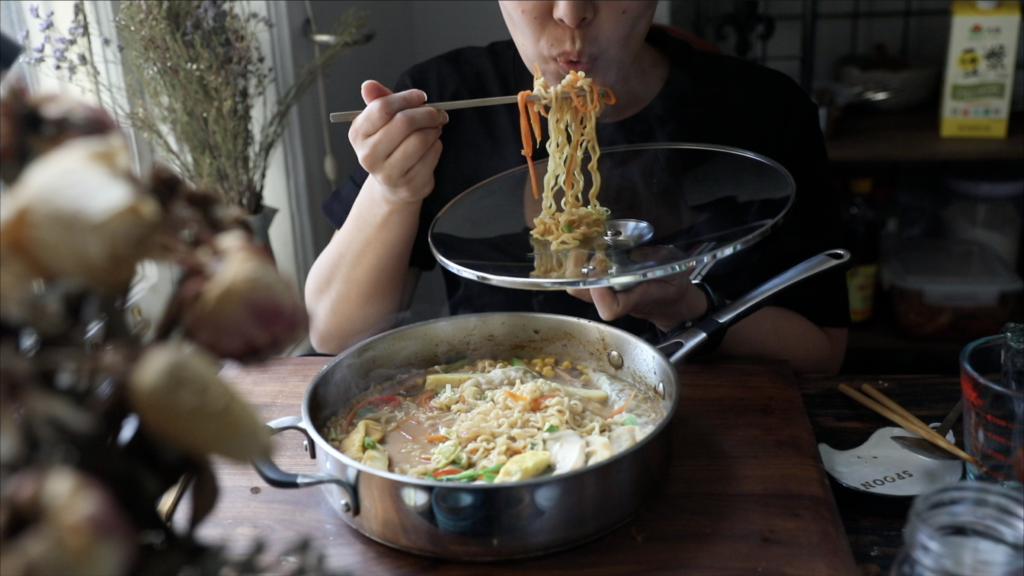
Author of The Korean Vegan cookbook, Joanne Molinaro started her food blog in 2016 when she turned to a plant-based diet. But it was after going viral on TikTok during the COVID-19 pandemic that she pivoted full-time to creating recipe videos. Today, she creates 60-second videos and blogs of vegan recipes of Korean food while sharing stories about her family – immigrants from what is now North Korea.
This ramen (or “lah-myun” in Korean) recipe puts a vegan spin on a popular trend. On TikTok, cooks make ramen rich and creamy by adding egg and mayonnaise to a bowl of ramen. In this vegan version, Korean soy milk and doenjang (fermented soybean paste) lend the same level of creaminess. With tons of vegetables, soy sauce, tofu, and noodles, just a few minutes create a spicy and satisfying noodle soup.
Seco de Chivo (Goat Stew)
Recipe by Layla Pujol
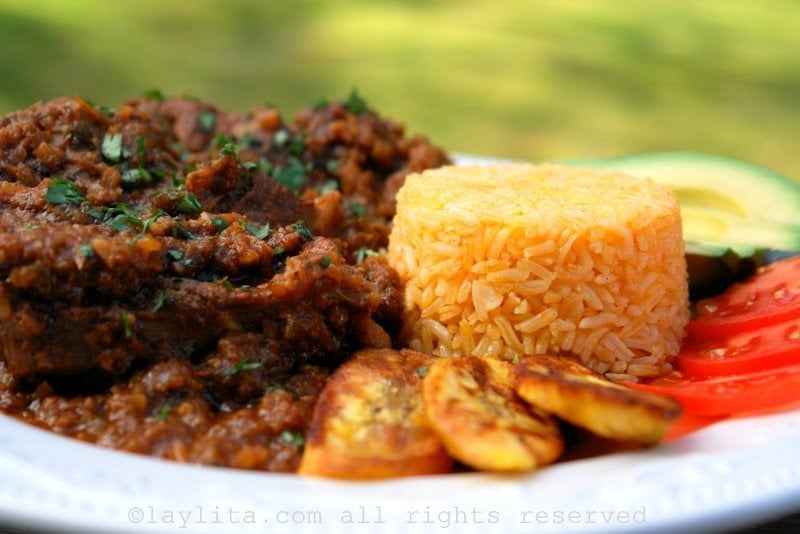
Cook Layla Pujol, who goes by Laylita, was born in Ecuador before moving to the U.S. and now living in Luxembourg. Her blog is full of recipes for the Ecuadorian dishes she grew up eating, but it also introduces readers to foods from across Latin America. Laylita draws on inspiration from family and friends cooking and eating across the world and celebrates Latin American culture as well as culinary tradition.
Seco de chivo, or goat stew, is a recipe for celebration! Laylita’s community prepared it only for fiestas when she was growing up. With tender goat meat and a sauce made with flavors like garlic, cumin, achiote, oregano, cilantro, and a fermented corn drink, this hearty goat stew can also be served with rice, fried plantains, or avocado!
Borscht
Recipe by Natasha Kravchuk

Natasha Kravchuk arrived to the U.S. with her family as a refugee at only four years old. When they left their home of Ukraine, the family knew no English at all – but they were committed to becoming part of their new community. Today, Natasha and her husband Vadim make videos and blogs of their recipes on Natasha’s Kitchen. There, she shares well-loved recipes – many of which come from family and friends – and include many from Russia and Ukraine.
Beets make borscht, a nutritious and delicious soup full of beans, potatoes, carrots, and cabbage, a striking red color. Full of vegetables and served with a dollop of sour cream on top, borscht is a classic dish in Ukraine and perfect for cold winter months. Just be careful to not stain your hands red with beets in the process!
Kadhi
Recipe by Priya Krishna

One of my favorite food writers is Priya Krishna, currently with The New York Times. She calls her cookbook Indian-ish a loving tribute to her mom’s cooking – Indian-American hybrids that are “easy to make, clever, practical, and packed with flavor.”
Her Kadhi recipe for Bon Appetit is all about being simple to make but full of complex flavor – what she describes as “a cozy blanket draped over a hot bowl of white rice.” The recipe comes in many variations across regions in India, and this version is full of spices and tinted the distinctive yellow color of turmeric.
Red Red Vegan Bean Stew
Recipe by Zoe Adjonyoh

In 2010, Zoe Adjonyoh started on a mission to “bring African foods to the masses.” Today, she is a recipe creator and ambassador for “New African Cuisine” and author of a popular cookbook called “Zoe’s Ghana Kitchen.”
She sees food as a powerful tool – a “bridge between cultures” that was also a way that she connected to her own family history in Ghana while growing up as the child of immigrants.
Recipes like this “Red Red Vegan Bean Stew” are a delicious way to learn a little bit about Ghana too! This stew made of black-eyed peas cooked in spiced tomato sauce is a meal eaten any time of day in Ghana. It’s a tasty, healthy, nourishing, and comforting food that is equally easy to make! To go the extra mile, serve with fried plantain on the side.
Cook and Eat!
These recipes bring flavors from countries across the globe as their creators blend old traditions with new techniques and their own spin. If you try any of these recipes, why not share some with a friend or neighbor? Or ask someone in your community to teach you how to cook their favorite food! If you do, post a photo on social media and be sure to tag World Relief Chicagoland. We can’t wait to see your culinary masterpiece!
Continue Reading
4 Resources From World Relief Staff That Have Shaped Their Journey: MLK Day
Watch this Family Reunite After 9 Years Apart
Why Family Reunification is Needed
Can you imagine fleeing your home? And not just leaving behind your community. Becoming separated from your family too.
Sadly, the circumstances that push refugees from their homes often separate families. And this creates countless hardships. Sometimes there are tragic consequences. The loss has a lasting emotional impact that affects other areas of life. In other words, it can prevent families from integrating into their new communities.
Thankfully, the United Nations refugee agency (UNHCR) sees family as a primary community, for every person. Because of that, UNHCR prioritizes family. Together, UNHCR and organizations like World Relief work to reunite husbands and wives, bring together parents and children, and connect children with their siblings. Above all, to restore relationships.
UNHCR promotes family reunification to protect and preserve the unity of this fundamental unit of society, to restore basic dignity to a refugee’s life, and especially to provide protection for children…
UNHCR
The Barriers to Reunification
However, the journey can be long. And it’s challenging. There is often an extensive waiting period after someone submits their application. Loss of formal documents can make it difficult for families to prove their relationships. Additionally, it can be expensive. Airfares, legal fees, and other costs add up. It can end up being thousands of dollars that families can’t afford. Beyond those costs, it can be hard to find affordable legal advice. Because of that, too many families go years without seeing each other.
But there is hope.
How World Relief Reunites Families
Every year, World Relief works to bring families back together. By providing free or affordable legal help, staff walk families through the whole process. First, staff can evaluate the case for reunification. Then help with submitting the application. They can sift through the required documentation. Then case managers can help with resettlement details. Finally, World Relief volunteers can even provide a ride to the airport. All of this can take years!
But it’s worth it to bring families back together.
Then when they are, it’s always an emotional experience.
Watch the video below to see one family’s emotional reunion at the airport.
Watch more videos of hope on World Relief Chicagoland’s YouTube channel!
More like this:
New Opportunity in the U.S.: Jenny’s Story
I Was No Longer Safe in My Country: Yomardy’s Story of Seeking Asylum

